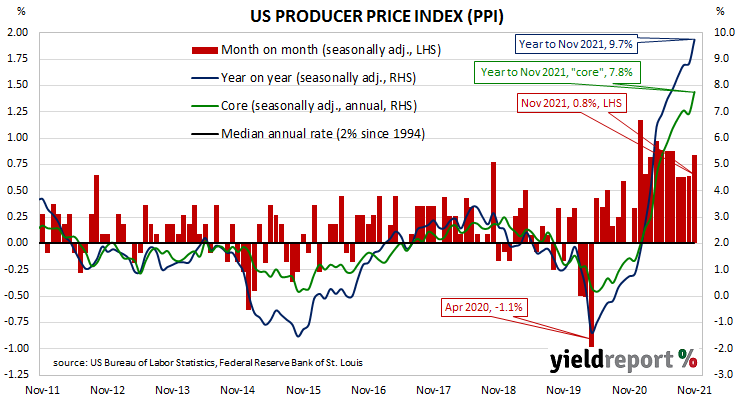Summary: Prices received by US producers (PPI) rise by 0.8% in October, above expectations; annual rate up from 8.8% to 9.7%; “core” PPI increases by 0.7%; biggest annual gain since 2010.
Around the end of 2018, the annual inflation rate of the US producer price index (PPI) began a downtrend which continued through 2019. Months in which producer prices increased suggested the trend may have been coming to an end, only for it to continue, culminating in a plunge in April 2020. Figures returned to “normal” towards the end of that year but recent months’ annual rates have been well above the long-term average.
The latest figures published by the Bureau of Labor Statistics indicate producer prices rose by 0.8% after seasonal adjustments in November. The increase was greater than the 0.5% rise which had been generally expected as well as October’s revised figure of 0.6%. On a 12-month basis, the rate of producer price inflation after seasonal adjustments accelerated from 8.8% to 9.7%.
PPI inflation excluding foods and energy, or “core” PPI inflation, rose by 0.7% after seasonal adjustments, greater than the consensus expectation of a 0.4% increase and October’s 0.4% rise. The annual rate accelerated from October’s revised rate of 6.9% to 7.8%.
“This was the biggest annual gain since the series began in 2010,” said NAB currency strategist Rodrigo Catril.
He noted the PPI for finished goods rose by 13.3% year on year, “the strongest since 1980.”
US Treasury bond yields only rose moderately on the day as investors traded cautiously ahead of a decision from the December meeting of the US FOMC. By the close of business, 2-year, 10-year and 30-year Treasury yields had all gained 3bps to 0.66%, 1.44% and 1.83% respectively.
The producer price index (PPI) is a measure of prices received by producers for domestically produced goods, services and construction. It is put together in a fashion similar to the consumer price index (CPI) except it measures prices received from the producer’s perspective rather than from the perspective of a retailer or a consumer. It is another one of the various measures of inflation tracked by the US Fed, along with core personal consumption expenditure (PCE) price data.


